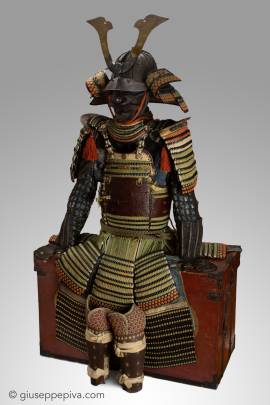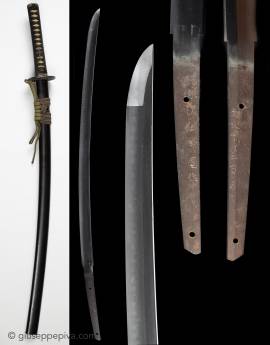Edo period, 18th centuryPair of two-panel folding screens Ink, colors, gofun and gold leaf on paperEach 170 by 165 cm The term karamono is used to define ceramic, carvel lacquerware, furniture, bronzes and other decorative items imported from China. They became highly prized as imported curios, used in Japan as kazari - display items - and even the shōgun would install karamono in his chamber (zashiki) and invite members of the court and clergy to view them. Often karamono have been copied by Japanese craftsmen, so shapes from Chinese bronzes and porcelain have been used in Japan for...
WORKS FOR SALE
Mid Edo period, 18th centuryKaga schoolEXHIBITIONMei Tō - Katchu Ten (“Exhibition of famous swords and armor”), Izumi National History Museum, 2002LITERATUREMei Tō - Katchu Ten, Izumi National History Museum, 2002, Cat. 56. Pag. 72CERTIFICATEThe armor accompanied by a certificate of registration as Koshu Tokubetsu Kicho Shiryo (Especially Important Armor Object) no. 1215 issued by the Nihon Katchu Bugu Kenkyu Hozon Kai (Japanese Armor Preservation Society), 2018.10.21 This authentic samurai suite of armor features some typical characteristics of Kaga’s armor...
Shinshinto Yoshikuni KatanaSigned Yonezawa-jū Kato Yoshikuni米沢住義国Date: February 1862文久四年二月日NBTHK Tokubetsu Hozon Tōken Nagasa [lenght]: 69.4 cmMotohaba: 3.1 cm, sakihaba: 2.5 cmSugata [configuration]: shinogi-zukuri, tori-zori, iori-mune, ō-kissakiKitae [forging pattern]: mokume hada mixed with dense ko-itameHamon [tempering pattern]: Toranba in tight nioi-deki; ashi, yō and kaninotsumeBōshi [point]: midarekomi that becomes komaruNakago [tang]: ubu, Sujikai yasurime; two mekugi-ana; ha-agari kuri JiriOrigami: the blade comes with a Tokubetsu Hozon Tōken (SwordParticularly Worth of...
Copyright © 2016 - giuseppe piva - VAT: 05104180962










